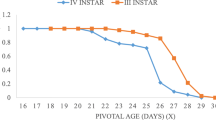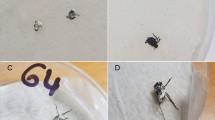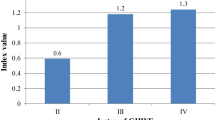Abstract
Pathogenicity of Lecanicillium muscarium, against Eretmocerus sp. nr. furuhashii (Hymenoptera: Aphelinidae), was investigated under laboratory conditions to determine if the fungal infection of the whitefly host can effect the survival, longevity and fecundity of female parasitoid. The results indicated that the number of parasitized larvae surviving a L. muscarium treatment after 6 days of oviposition decreased with increasing concentrations of L. muscarium and in later stages of development (12 days post oviposition) were not affected by fungal application. There were no significant differences on adult parasitoid survivorship after 7 days among all treatments. Maximum survivorship (73.33%) was observed for control and it was minimum (60%) at 1 × 108 conidia/ml. L. muscarium showed a non significant effect on longevity and next offsprings of female parasitoids. The percentage emergence of parasitoids from the whitefly nymphs produced by the females emerged from treated pupae was almost similar. Maximum emergence (69.77%) was observed at 1 × 106 conidia/ml and it was lowest (61.02%) at conidial concentration of 1 × 108 conidia/ml. Maximum longevity of adult Eretmocerus sp. emerging from whitefly nymphs when treated after 12 days of postoviposition was observed for 1 × 105 conidia/ml having a mean value of 5 days whereas the lowest longevity was 4.9 days observed at 1 × 108 conidia/ml. The results mentioned above indicate that the interaction among biocontrol agents is positive to a greater extent with minimum risk hazards.
Similar content being viewed by others
References
Beegle CC, Oatman ER (1975) Effect of nuclear polyhydrosis virus on the relationship between Trichoplusia ni (Lepidoptera: Noctuidae) and the parasitoid Hyposoter exiguae (Hymenoptera: Ichneumonidae). J Invertebr Pathol 25:59–71. doi:10.1016/0022-2011(75)90285-2
Bethke JA, Parella MP (1989) Compatibility of aphid fungus Cephalosporium lecanii with leafminer parasite. Diglyphus beginii. Pan-Pac Entomol 64:385–390
Biloti E (1955) Survie des larves endophages de Tachinaires a un mort premature de lure hote par maladie. C R Acad Sci 240:1021–1023
Brooks WM (1993) Host parasitoid pathogen interactions. In: Beackage N, Thompson NS, Federici BA (eds) Parasites and Pathogen of Insects. Academic Press, San Diego, pp 231–272
El-Sufty R, Führer E (1981) Parasitare veranderungen der wirtskutikula bei Pieris brassicae and Cydia pomonella durch entomophage Endoparasiten. Entomol Exp Appl 30:134–139. doi:10.1007/BF00300878
Fransen JJ, van Lenteren JC (1993) Host selection and survival of the parasitoid Encarsia formosa after treatment of parasitized greenhouse whitefly, Traileurodes vaporariorium, in the presence of hosts infected with the fungus Ashersonia alyerodis. Entomol Exp Appl 69:239–249. doi:10.1007/BF02381996
Fransen JJ, van Lenteren JC (1994) Survival of the parasitoid Encarsia formosa after treatment of parasitized greenhouse whitefly larvae with fungal spores of Ashersonia alyerodis. Entomol Exp Appl 71:235–243. doi:10.1007/BF02426407
Fransen JJ, Winkelman K, van Lenteren JC (1987) The differential mortality at various life stages of the greenhouse whitefly Trialeurodes vaporariorum (Homoptera: Aleyrodidae), by infection with the fungus Aschersonia aleyrodis (Deutromycotina: Coelomycetes). J Invertebr Pathol 50:158–165. doi:10.1016/0022-2011(87)90116-9
Furlong MJ (2004) Infection of the immature stages of Diadegma semiclausum, an endolarval parasitoid of the diamondback moth, by Beauveria bassiana. J Invertebr Pathol 86:52–55. doi:10.1016/j.jip.2004.03.006
Gerling D (1990) Natural enemies of whiteflies: predators and parasitoids, In: Gerling D (Ed) Whiteflies: theirs bionomics, pest status and management. Intercept, Andover, pp 147–185
Gerling D, Fried R (2000) Biological studies with Eretmocerus mundus (Hymenoptera: Aphelinidae). J Econ Entomol 87:117–123
Gerling D, Tremblay E, Orion T (1991) Initial stages of vital capsule formation in the Eretmocerus—Bemesia tabaci association. Redia (Firenze) 74:411–415
Godfray HCJ, Shimada M (1999) Parasitoids as model organisms for ecologists. Res Pop Ecol 41:3–10. doi:10.1007/PL00011980
Goettel MS, Poprawski TJ, Vanderberg JD, Li Z, Roberts DW (1990) Safety to non-target invertebrates of fungal biocontrol agents. In: Laird M, Lacey LA, Davidson EW (eds) Safety of Microbial Insecticides. CRC Press, Boca Raton, pp 209–232
Goettel MS, Inglis GD, Wraight SP (2000) Fungi hyphomycetes. Manual of techniques in insect pathology. Academic Press, Netherlands, pp 643–245
Hall RA (1981) The fungus Verticillium lecanii as a microbial insecticide against aphids and scales. In: Burges HD (ed) Microbial control of pests and plant diseases 1970–1980. Academic Press, New York, pp 483–498
Keller S (1975) Histologische Untersuchungen an parasitierten, Entomophthora infizierten Erbsenblattläusen Acyrthosiphon pisum. Mitt Schweiz Entomol Ges 48:247–252
Kirk AA, Lacey LA, Brown JK, Ciomperlik MA, Goolsby JA, Vacek DC et al (2000) Variation in the Bemisia tabaci, 1. Species complex (Hemiptera: Alyerodidae) and its natural enemies leading to successful biological control of B. tabaci biotype B in the USA. Bull Entomol Res 90:317–327. doi:10.1017/S0007485300000444
Lacey LA, Mesquita ALM, Mercadier M, Debire R, Kazmer DJ, Leclant F (1997) Acute and sublethal activity of the entomopathogenic fungus Paecilomyces fumosoroseus (Deuteromycotina: Hyphomycetes) on adult Aphelinus asychis (Hymenoptera: Aphelinidae). Environ Entomol 26:1452–1460
Prabhaker N, Toscano NC, Coudriet DL (1989) Susceptibility of the immature stages of the sweetpotato whitefly Bemisia tabaci (Homoptera: Aleyrodidae) to selected insecticides. J Econ Entomol 82:983–988
Qui BL, Ren SX, Xiao Y, Mandour NS (2004) Effectiveness of Eretmocerus sp and Aschersonia aleyrodis in controlling Bemisia tabaci population. Bull Entomol Res 14:2251–2254
Roudrigues MD, Moreno R, Tellez MM (1994) Eretmocerus mundus (Mercet), Encarsia lutea (Masi) y Encarsia transcera (Timberlake) (Hymenoptera: Aphelinidae) parasitoides de Bemisia tabaci (Homoptera: Alyerodidae) en los cultivos horticolas protegidos almerienses. Bol Sanid Veg, Plagas 20:695–702
Roy HE, Pell JK (2000) Interactions between entomopathogenic fungi and other natural enemies: Implications for biological for biological control. Biocontrol Sci Technol 10:737–752. doi:10.1080/09583150020011708
SAS Institute Inc (2000) SAS/STAT Version 8.1: Statistics. SAS Institute, Cary
Wang L, Huang J, You M, Liu B (2004) Time-dose-mortality modeling and virulence indices for six strains of Verticillium lecanii against sweetpotato whitefly, Bemisia tabaci (Gennadius). J Appl Entomol 128:494–500. doi:10.1111/j.1439-0418.2004.00879.x
Zare R, Gams W (2001) A revision of Verticillium section Prostrata IV The genera Lecanicillium and Simplicillium gen nov. Nova Hedwigia 73(1–2):1–50
Acknowledgments
The research was funded by grants from the basic research program (Program.973) (2006CB102005) and Agricultural special foundation (200803005).
Author information
Authors and Affiliations
Corresponding author
Additional information
Communicated by M. Traugott.
Rights and permissions
About this article
Cite this article
Lazreg, F., Huang, Z., Ali, S. et al. Effect of Lecanicillium muscarium on Eretmocerus sp. nr. furuhashii (Hymenoptera: Aphelinidae), a parasitoid of Bemisia tabaci (Hemiptera: Aleyrodidae). J Pest Sci 82, 27–32 (2009). https://doi.org/10.1007/s10340-008-0215-z
Received:
Revised:
Accepted:
Published:
Issue Date:
DOI: https://doi.org/10.1007/s10340-008-0215-z




